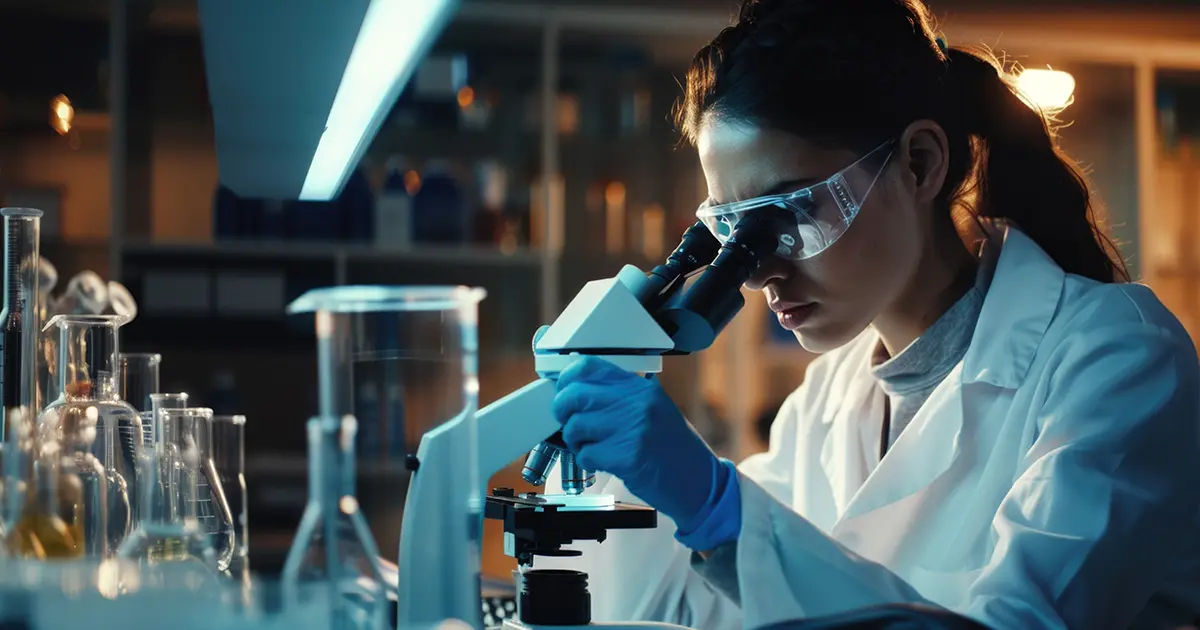
I. Introduction
Glutrasol and Transfer Factor Ultra products are comprised of three main ingredients:
- Transfer Factor: A transfer factor is a chemical taken from a human or animal that has already developed protection (immunity) against a certain disease.
- Glucans: A glucan is a polysaccharide derived from D-glucose, linked by glycosidic bonds. Glucans are noted in two forms: alpha-glucans and beta-glucans.
- Lactic Acid-generating Bacteria: Lactic acid bacteria are a group of Gram-positive bacteria, non-respiring, non-spore-forming cocci or rods, that produce lactic acid as the primary end product of the fermentation of carbohydrates.
This disclosure focuses on the Biochemistry Transfer Factor.
Glutrasol and Transfer Factor Ultra work because TEST groups repeatedly show dramatic improvement relative to CONTROL groups.
Here is information on how (biochemically) they work.
II. Inducer/Suppressor Fraction of Transfer Factor
T-lymphocytes produce transfer factors and can transfer the ability to recognize a pathogen to cells that have not been in contact with the pathogen. They also heighten the immune system’s ability to react (increased reactivity or inducer function) to pathogens. Transfer factor produces a trigger for T-cell recognition of antigen.
The transfer factor is a mixture of peptides, typically with a molecular weight < 10,000 Daltons. It’s more appropriate to speak of “transfer factors” instead of “transfer factor.” Fortunately, today’s preparative methods produce consistent mixtures, which lead to repeatable responses.
Fractions within the mixture serve different (and sometimes opposite) purposes. Two significant fractions are (1) the inducer fraction and (2) the suppressor fraction [1][2]. Opposing functions were confirmed using the direct Leucocyte Migration Inhibition (LMI) test.
These two fractions are consistent with field observations that the transfer factor balances the immune system.
For example:
- The inducer fraction of transfer factor biochemistry links the immune cells with an antigen-binding site, thereby increasing their reactivity to an antigenic stimulus. This is advantageous when a higher immune response is required. CortControl’s enhanced vaccine response arises from an inducer fraction. Several researchers have documented the inducer effects of transfer factors [3][4][5].
- The suppressor fraction blocks the response of the T-cells and signals a down-regulation of the immune response. This is helpful in allergic or autoimmune conditions. Animal studies demonstrate improvement in cases where the immune system is over-active. This arises from suppressor fraction. Cortesini R. et al. [6] showed that CD8+CD28-Ts represent a unique subset of regulatory cells within the transfer factor that initiates a suppressive loop. Filaci [7] supported Cortesini’s work and related autoimmune diseases without CD8+ suppressor T lymphocytes. Filaci further found that “CD8+ Ts can be generated in vitro from CD8+CD28-T lymphocytes. A key role in their generation is played by monocytes that secrete interleukin-10 (IL-10) after granulocyte macrophage-colony-stimulating factor (GM-CSF) stimulation.”
Aleli Salazar-Ramiro et al. [8] view cancer as an autoimmune disease and propose a transfer factor for cancer therapy. This is supported by CortControl’s veterinary work on horses, dogs, and cows [9], where cancer symptoms were visibly reversed.

Glutrasol Dietary Supplement
Glutrasol offers therapeutic levels of transfer factors, glucans, prebiotics and probiotics, vitamins, and minerals and has a rich vanilla flavor.
III. TH1/TH2 Helper Cells and Cytokines
Reviewing the helper lymphocyte paradigm helps categorize the transfer factor applications. Helper lymphocytes develop along two cell populations: TH1 and TH2. Transfer factors from both lymphocyte lines are represented in the transfer factor biochemistry. TH1 and TH2 cells perform different functions and produce different cytokines—proteins that function as messenger molecules.
Cell-mediated or TH1 helper responses are essential in the body’s ability to defend itself against viruses, fungi, parasites, cancer, and intracellular organisms. TH1 cells modulate cell-mediated immunity.
TH1 cells produce the following cytokines:
- IL-2,
- IFN-gamma, and
- TNF-alpha
TH2 cells modulate humoral immunity (antibody production).
TH2 cells produce the following cytokines:
- IL-4,
- IL-5,
- IL-6,
- IL-10, and
- IL-13
Cytokines are functionally similar to hormones but are not associated with a specific gland.
They appear to operate as keys and templates.
- Cytokines are a broad and loose category of small proteins essential in cell signaling. Due to their size, cytokines cannot cross the lipid bilayer of cells to enter the cytoplasm and, therefore, typically exert their functions by interacting with specific cytokine receptors on the target cell surface.
Stereochemistry is important.
What is stereochemistry in simple terms?
- A branch of chemistry that deals with the spatial arrangement of atoms and groups in molecules.
- The spatial arrangement of atoms and groups in a compound and its relation to the properties of the compound.
The attachment of a cytokine to an immune cell receptor starts a specific immune signal within the target cell. Signals translate into direct action, increase the production of antibodies against an invading virus, or initiate the production of other cytokines to propagate the signal.
IV. TH1/TH2 Predominant Phenotypes
One aspect of immune regulation involves homeostasis between T-helper 1 (Th1) and T-helper 2 (Th2) activity [10]. TH1/TH2 balance correlates with good health, and over-activation in either direction sets the stage for disease.
Th1 and Th2-helper cells direct different immune response pathways and produce different cytokines. Either pathway can down-regulate the other.
Steven Bock, MD, correlated disease conditions to an imbalance of TH1 and TH2. For example, if one has a TH2-dominated condition, the disease conditions that tend to prevail are:
- Allergies
- Chronic sinusitis
- Atopic eczema
- Asthma
- Systemic autoimmune conditions such as lupus erythematosus and mercury-induced autoimmunity
- Vaccination-induced state
- Certain cases of autism
- Hyperinsulinism
- Pertussis vaccination
- Malaria
- Helminth infection
- Hepatitis C
- Chronic giardiasis
- Hypercortisolism
- Chronic candidiasis
- Cancer
- Viral infections
- Ulcerative colitis
If one has a TH1-dominated condition, the conditions that tend to prevail are:
- Diabetes type 1
- Multiple sclerosis
- Rheumatoid arthritis
- Uveitis
- Crohn’s disease
- Hashimoto’s disease
- Sjögren’s syndrome
- Psoriasis
- Sarcoidosis
- Chronic Lyme disease
- H. pylori infections
- E. histolytica
Glutrasol field observations show successes in both categories. For example, international travelers avoid flu and colds by consuming Glutrasol before a trip. In addition, Ramaekers Nutrition has success with psoriasis, Crohn’s disease, and H pylori infections (among a 20-year list of others). The biochemistry of transfer factor in Glutrasol contains cytokines from both TH1 and TH2 cells. It produces different cytokines for different situations.
Alvarez-Thull L, Kirkpatrick CH [11] note that “Transfer factor treatment selectively affects cytokine production in response to antigenic stimulation.”
Fabre RA et al. [12] (in a pulmonary tuberculosis study) showed that “the treatment with murine or human TF [transfer factor] restored the expression of TH-1 cytokines, TNFalpha and iNOS, provoking inhibition of bacterial proliferation and significant increase of DTH and survival.”
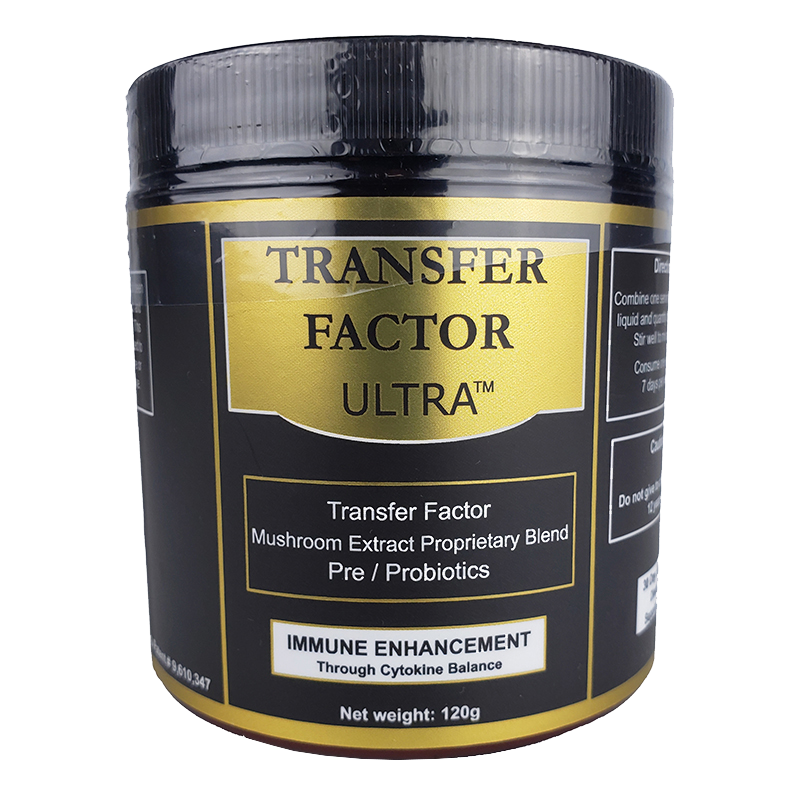
Transfer Factor Ultra
Transfer Factor Ultra ingredients are formulated at therapeutic levels for severe illness or as prevention for significant health challenges. As with any supplement, it is advisable to seek advice from your healthcare professional to ensure it suits you.
V. Adjusting to Change
Malaria is cited as a TH2-dominated condition WHO [13] and PATH are working on a robust malaria vaccine.
CortControl acknowledges that parasites can mutate [14] and present a changing appearance to the immune system. This is one reason for the cyclical flare-ups experienced by malaria victims. Antibody vaccines are specific and not designed to keep pace with mutations.
Maturation time for TH1 or TH2 cells is 10-14 days. In contrast, the biochemistry of transfer factor works on the innate immune system and responds within 24-48 hours. Transfer factor empowers the immune system to stay current with mutations.
CortControl predicts that the immediate benefits of combining Glutrasol with malaria vaccine will be:
- Increasing vaccine efficiency and
- Minimizing relapse or re-infection.
VI. Rebalancing TH1 and TH2 Levels
Transfer factor can change TH1/TH2 predominance conditions within 48 hours [15].
This observation asks, “How can Transfer Factor change a predominantly TH-2 Immune System to a predominant TH-1 System so rapidly?”*
*The hypothesis of new TH1 cells was dismissed early because it takes 10-14 days to mature new TH1 cells.
The answer is “conversion by eomesodermin,” which was studied [16] in 2003.
- Eomesodermin. Also known as T-box brain protein 2, is a protein encoded by the EOMES gene in humans. The Eomesodermin/Tbr2 gene, EOMES, encodes a member of a conserved protein family that shares a common DNA-binding domain, the T-box.
In that study, already-differentiated TH2 cells were converted to TH1 cells. Eomesodermin is a T-box transcription factor related to T-bet and is already characterized as a key regulator of mesodermal differentiation. Eomesodermin was up-regulated explicitly in activated CD8+ cells [one of the transfer factor’s actions].
The conversion of TH2 to TH1 cells applies to viral vaccines and malaria, which tend to be TH2-dominated. In the opposite direction, the conversion of TH1 to TH2 is advantageous for Rheumatoid arthritis or Crohn’s disease.
VII. Viruses, Bacteria, and Parasites
Web MD notes, “Transfer factors are used for infectious conditions in people with weak immune systems. These infectious conditions include bacteria or viruses in the bloodstream (septicemia), sinus infections, bronchitis, influenza, swine flu, the common cold, shingles, chickenpox, hepatitis B, fungal infections such as coccidioidomycosis, yeast infections (candidiasis), parasitic infections such as leishmaniasis and cryptosporidiosis, and leprosy.
Transfer factors are also used against infections caused by viruses such as cytomegalovirus (CMV) and Epstein-Barr virus, bacteria such as Mycobacterium tuberculosis, Mycobacterium fortuitum, and Mycobacterium avium, and yeast-like fungi such as Cryptococcus and Pneumocystis carinii.
The Glutrasol formulation dramatically lowered the mortality rate of parasite-infected livestock herds [9]. Simultaneously, weight gain improved.
CortControl does not believe that we “cured” the affected herds. Instead, we believe Glutrasol better staged the subject’s immune system to resist parasites and opportunistic infections.
This immune response has applications for countries where water-borne parasites negatively affect child development.
Stunted childhood growth is a significant global health issue. Low weight gain in livestock and stunted human growth are probably related.
VIII. Staging the Immune System
The response to vaccination depends on the recipient’s health. Vaccines work best for healthy people. Conversely, a person with a weakened immune system may not receive the calculated vaccine benefits. This relationship is significant in less developed countries, where unsanitary conditions impact overall health.
Dr Mandal [17] notes, “This [a lower-than-expected vaccine response] could be due to various reasons. Sometimes, this is because the host’s immune system doesn’t respond adequately or at all. This could be in diseased persons with lowered immunity, e.g., in people with diabetes, those on steroids or other immunity-suppressing drugs, or those with HIV infection.
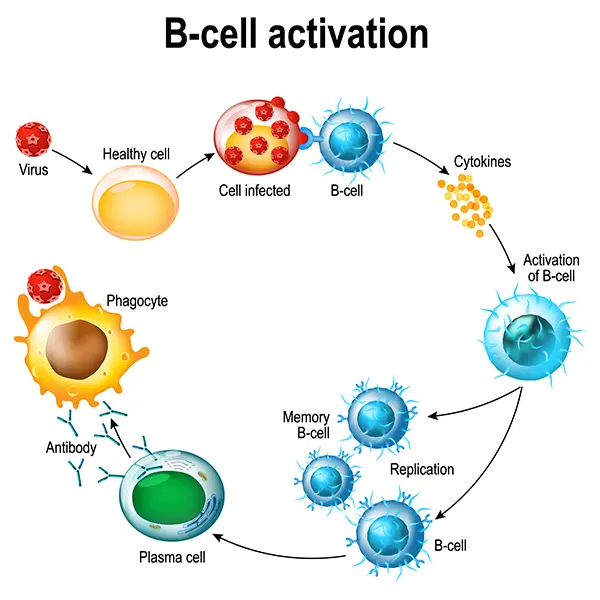
The non-development of immunity to disease could also be because the host’s immune system does not have a B cell capable of generating antibodies against the antigen or microbe or the immune system may not be strong enough to fight off the infection”.
Glutrasol. Formulated to narrow the health gap and make vaccine benefits accessible to a larger population.
IX. Adjuvant Application
Several articles suggest the use of the Transfer Factor as an adjuvant.
- An adjuvant is a chemical substance added to some vaccines to help the body’s immune system respond more effectively to the vaccine’s antigens.
Schroder et al. [18] state, “This interspecies adjuvant effect was proportional to the dose of the ‘transfer-factor’ preparations administered, depended on the method of their preparation, and was expressed in the administration of the preparations simultaneously with the immunization.”
Wang et al. [19] state, “In conclusion, these results suggest that TF [transfer factor] possess better cellular immune-enhancing capability and would be exploited into an effective immune-adjuvant for inactivated vaccines.”
X. Dramatic Pictures of Results of Consuming Transfer Factor
The following images are two patient examples. We have an extensive database of animal results using our patented formulas.
Calf with Severe Warts
Before Transfer Factor Consumption
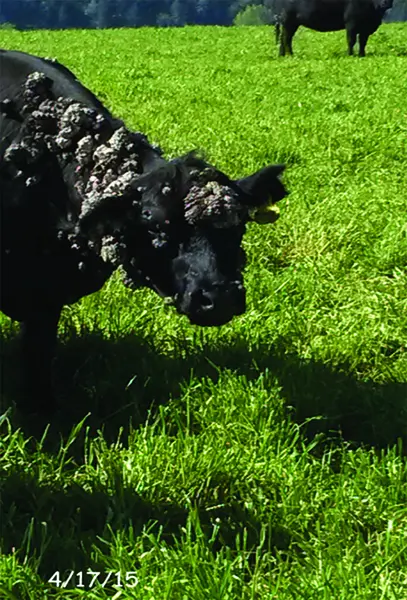
6 Months Later
After Transfer Factor Consumption

Horse with Eye Cancer
Before Transfer Factor Consumption
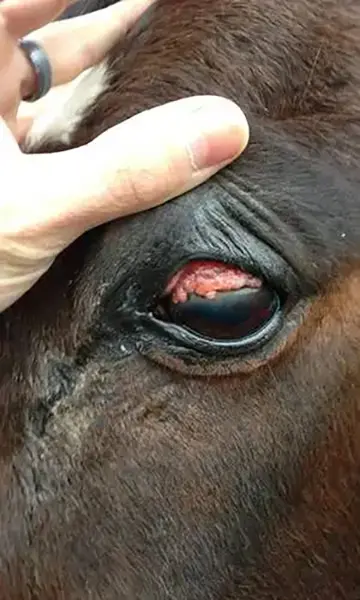
During Transfer Factor Consumption
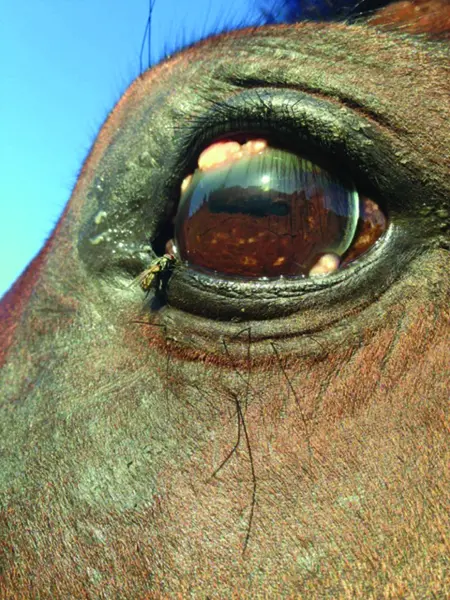
After Transfer Factor Consumption

References
- Lawrence HS, Borkowsky W., “Transfer factor—current status and future prospects,” Biotherapy 1996;9(1-3):1-5. https://www.ncbi.nlm.nih.gov/pubmed/8993750
- www.linked2.info/dvm
- Mazaheri R, Hamblin AS, Zuckerman AJ., “Cell-mediated immunity: correlation of mixed-leucocyte-macrophage migration inhibition with delayed-type hypersensitivity after immunization and donor-specific transfer of cell migration inhibition by dialyzable leucocyte extract,” Cell Immunol. 1983 Nov;82(1):147-62. https://www.ncbi.nlm.nih.gov/pubmed/6196129
- Kirkpatrick CH, Rich RR, Smith TK., “Effect of transfer factor on lymphocyte function in anergic patients,” J Clin Invest, 1972 Nov;51(11):2948-58. https://www.ncbi.nlm.nih.gov/pubmed/5080419
- Salazar-Ramiro A, Hernández-Pedro NY, Rangel-Lopez E, Cruz VPD, Estrada-Parra S, et al., “Dialyzable Leukocyte Extract (Transfer Factor) as Adjuvant Immunotherapy in the Treatment of Cancer,” MOJ Auto Dis 1(1): 00003. DOI: 10.15406/mojad.2016.01.00003.
- Cortesini R1, LeMaoult J, Ciubotariu R, Cortesini NS., “CD8+CD28- T suppressor cells and the induction of antigen-specific, antigen-presenting cell-mediated suppression of Th reactivity”, Immunol Rev. 2001 Aug;182:201-6. https://www.ncbi.nlm.nih.gov/pubmed/11722635
- Filaci G. et al., “Nonantigen specific CD8+ T suppressor lymphocytes originate from CD8+CD28- T cells and inhibit both T-cell proliferation and CTL function”, Hum Immunol. 2004 Feb;65(2):142-56. https://www.ncbi.nlm.nih.gov/pubmed/14969769
- Salazar-Ramiro A, Hernández-Pedro NY, Rangel-Lopez E, Cruz VPD, Estrada-Parra S, et al., “Dialyzable Leukocyte Extract (Transfer Factor) as Adjuvant Immunotherapy in the Treatment of Cancer,” MOJ Auto Dis 1(1): 00003. DOI: 10.15406/mojad.2016.01.00003. http://medcraveonline.com/MOJAD/MOJAD-01-00003.php
- http://ramaekersnutrition.com/library/the-mechanism-of-transfer-factor/
- Kidd P., “Th1/Th2 balance: the hypothesis, its limitations, and implications for health and disease”, Altern Med Rev. 2003 Aug; 8(3):223-46. https://www.ncbi.nlm.nih.gov/pubmed/12946237
- Kirkpatrick CH, Rich RR, Smith TK., “Effect of transfer factor on lymphocyte function in anergic patients,” J Clin Invest, 1972 Nov;51(11):2948-58. https://www.ncbi.nlm.nih.gov/pubmed/5080419
- https://www.ncbi.nlm.nih.gov/pubmed/15086383
- http://www.who.int/mediacentre/factsheets/fs094/en/ “Malaria Fact sheet N 94”. WHO. March 2014.
- http://www.theexpandedheart.com/Transfer.html
- http://ramaekersnutrition.com/library/the-mechanism-of-transfer-factor/
- SCIENCE, p. 1041, Vol. 302, Nov. 2003. http://science.sciencemag.org/content/302/5647
- http://www.news-medical.net/health/Vaccine-Effectiveness.aspx
- https://www.ncbi.nlm.nih.gov/pubmed/419903
- www.ncbi.nlm.nih.gov/pubmed/22705080
